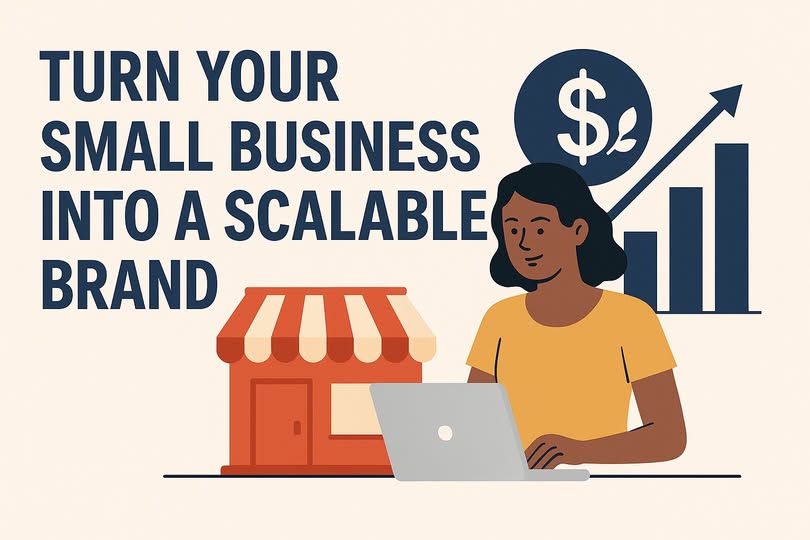Every great brand starts as a small idea.
Think about the local coffee shop you love, the one where the barista knows your order by heart. It started with a passion for good coffee and a desire to create a welcoming space.
But what happens when that single shop has lines out the door, and customers in the next town start asking when they’ll open a location there?
This is the turning point where a small business to start with faces a big question: how do you grow without losing the magic that made you special? This is the journey from a business to a scalable brand.

I remember a small bakery that opened down the street from my old apartment. Their sourdough was legendary. For the first year, it was a one-woman show. The owner, Sarah, was the baker, cashier, and marketer. The business was her, and her personal touch was in every loaf. But as word spread, she couldn’t keep up. She was selling out by 10 a.m. and turning away disappointed customers. She had a successful business, but it wasn’t scalable. To grow, she had to figure out how to replicate the quality and experience without being physically present for every single transaction.
Scaling isn’t just about getting bigger; it’s about growing smarter. It’s about building systems, a strong brand identity, and a loyal community that can grow with you. It’s about turning your secret sauce into a recipe that others can follow.
This guide will help you through the essential steps to transform your beloved small business into a powerful, scalable brand.
Solidify Your Brand Foundation
Before you can scale, you need a rock-solid foundation. A brand is more than just a logo or a color palette; it’s the promise you make to your customers. It’s the feeling they get when they interact with your business. To scale, this feeling must be consistent, whether they’re visiting your first store or your fiftieth, your website, or your social media page.
Define Your Mission and Vision
Why does your business exist beyond making a profit? Your mission is your purpose, your “why.” Your vision is where you see the business going in the future. For Sarah’s bakery, her mission might have been “to bring joy to the community through handcrafted, wholesome bread.” Her vision could be “to have our bread on every family’s dinner table in the state.” These statements become your North Star, guiding every decision as you grow. When you’re considering a new product or a new market, you can ask: does this align with our mission and vision?
Know Your Unique Value Proposition (UVP)
What makes you different from everyone else? Your UVP is a clear statement that describes the benefit you offer, how you solve your customer’s needs, and what distinguishes you from the competition. Is it your exceptional customer service? Your innovative product? Your commitment to sustainability? For the bakery, the UVP was “The only bakery in town using a 100-year-old sourdough starter for a truly unique flavor and gut-friendly bread.” This isn’t just a tagline; it’s a core component of the brand that must be protected and communicated at every touchpoint.
Systematize for Success
The biggest barrier to scaling is often the founder themselves. When you’re used to doing everything, it’s hard to let go. However, you cannot be everywhere at once. Scaling requires creating systems and processes that allow your business to run smoothly without your constant intervention.
Document Everything
Remember Sarah, the baker? To scale, she needed to document her entire process. This meant writing down her sourdough recipe in minute detail, outlining the baking schedule, and creating a step-by-step guide for customer service. This “operations manual” is crucial. It ensures that every new employee can be trained to deliver the same quality and experience that customers have come to expect. From how to answer the phone to how to package a product, documenting your processes creates consistency, which builds trust.
Leverage Technology
Technology is a small business owner’s best friend when it comes to scaling. This doesn’t have to mean expensive, complex software. It can start simple:
- Customer Relationship Management (CRM): A system to manage customer data, track interactions, and personalize communication.
- Project Management Tools: Platforms like Asana, Trello, or Monday.com can help you manage tasks, delegate responsibilities, and keep your team aligned as it grows.
- Inventory Management: Software that automatically tracks stock levels prevents sell-outs and overstocking, saving you money and keeping customers happy.
- Marketing Automation: Tools to schedule social media posts, send automated email sequences, and nurture leads allow you to reach a larger audience with less manual effort.
By automating repetitive tasks, you free up your time to focus on high-level strategy and the future of your brand.
Build a Team That Embodies Your Brand
You cannot scale alone. Building a team is one of the most critical steps. The key is to hire people who not only have the right skills but also align with your company culture and mission. Your first employees are your brand ambassadors. They will shape the culture and represent your brand to customers.
When hiring, look for passion and a belief in your mission. An employee who is excited about your sourdough is more likely to provide an enthusiastic customer experience than someone who is just there for a paycheck.
Once you have your team, empower them. Give them the training and tools they need to succeed, but also give them the autonomy to make decisions. When an employee feels trusted and valued, they take ownership of their role. They become problem-solvers and innovators who will help you grow the brand in ways you might not have imagined.
Craft a Consistent and Memorable Brand Identity
As you grow, you won’t be the only person communicating your brand’s message. A strong brand identity ensures that whether a customer interacts with your social media, your website, or a new employee, the experience feels consistent.
Focus on Digital Channels
A strong online presence is non-negotiable for a scalable brand. This includes a professional website, active social media profiles, and email marketing. Content marketing is particularly powerful. By creating valuable content—like blog posts, videos, or tutorials—you can establish yourself as an authority in your industry and attract customers organically.
Encourage User-Generated Content (UGC)
Your happiest customers are your most effective marketers. Encourage them to share their experiences online. For Sarah’s bakery, this could be a “show us your sourdough” photo contest on Instagram. UGC is authentic, trustworthy, and provides social proof that can attract new customers. It also builds a community around your brand, making customers feel like they are part of something special.
As you look to expand your reach, it’s important to have a clear roadmap. I have shared powerful tactics in my guide on sustainable business growth roadmap, emphasizing the need for a multi-channel approach that combines both digital and traditional methods tailored to your specific audience. Exploring these frameworks can provide a structured path to sustainable expansion.
Never Lose Sight of the Customer
Finally, no matter how big your brand becomes, never lose focus on the customer.
The personal touch that made your small business successful can still exist at scale, but it looks different. It’s less about you personally knowing every customer and more about creating systems that make every customer feel seen and valued.
This can be achieved through personalized email marketing, a responsive customer service team, and actively listening to feedback on social media. Continue to gather feedback through surveys and reviews, and use that information to improve. Brands that listen to their customers and adapt are the ones that thrive in the long run.
Turning your small business into a scalable brand is a marathon, not a sprint. It’s a journey of transforming your passion into a replicable, robust system. By building a strong brand foundation, systematizing your operations, empowering a dedicated team, and crafting a scalable marketing strategy, you can grow your business without sacrificing the soul that made it special in the first place.
Like Sarah’s bakery, you can go from a local favorite to a household name, all while keeping the promise you made to your very first customer.
From Business Owner to Brand Architect
The first shift is mental. You need to stop thinking like a small business owner who does everything and start thinking like an architect designing a skyscraper. You don’t lay every brick yourself; you create the blueprint so others can help you build.
Find Your “Why” and Tell Its Story
Every great brand has a story. It’s the soul of your business, the reason you get up in the morning. This isn’t just a marketing gimmick; it’s the core of your connection with your audience.
Think about Tom’s Shoes. The business model was simple: sell a pair of shoes, give a pair away. But the story was powerful. It was about purpose, about making a difference. People didn’t just buy shoes; they bought into a mission. That emotional connection is what makes a brand memorable and scalable.
What’s your story?
- The Origin: Why did you start this business? Was it to solve a problem you faced personally?
- The Mission: What impact do you want to have on your customers or the world?
- The Values: What principles guide every decision you make?
Write this story down. Weave it into your website’s “About Us” page, your social media posts, and even your packaging. Your story is the foundation upon which you’ll build everything else.
Grow Your Audience, Not Just Your Customer List
A scalable brand has a community, not just a list of transactions. It’s about building relationships with people who believe in what you do. These are the people who will become your evangelists, spreading the word far more effectively than any ad campaign.
Create Valuable Content
Content is how you build a relationship with your audience at scale. It’s how you provide value beyond your product or service. By sharing your expertise, you build trust and establish yourself as an authority in your field.
Your content strategy could include:
- Blogs: Answer the common questions your customers ask.
- Videos: Show behind-the-scenes glimpses or create helpful tutorials.
- Social Media: Share tips, tell stories, and engage in conversations.
The key is consistency and value. Don’t just sell; serve. Help your audience solve their problems, and they will remember you when they’re ready to buy.
Listen and Engage
Scaling doesn’t mean becoming a faceless corporation. It’s more important than ever to listen to your audience. Pay attention to social media comments, reviews, and customer emails. What are people saying? What do they love? What are their pain points?
This feedback is gold. It provides you with ideas for new products, content, and ways to improve your service. Engaging with your community makes them feel seen and valued, strengthening their loyalty to your brand.
Prepare for the Future
Building a scalable brand is a marathon, not a sprint. It requires foresight and a willingness to let go.
Know Your Numbers
To grow sustainably, you must understand the financial health of your business. This goes beyond just knowing your revenue. You need to track key metrics like:
- Customer Acquisition Cost (CAC): How much does it cost to get a new customer?
- Customer Lifetime Value (CLV): How much revenue does a customer generate over their entire relationship with you?
- Profit Margins: What is the real profit on each product or service you sell?
Understanding these numbers helps you make smart decisions about where to invest your time and money. It tells you if your growth is profitable and sustainable.
Build a Team and Learn to Delegate
You cannot scale if you remain the bottleneck. The goal of creating systems and documenting processes is to eventually hand those tasks over to someone else.
Hiring your first employee or freelancer is a huge step. It can be scary to trust someone else with your baby. But it’s essential for growth. Start small. Delegate one well-documented task and see how it goes. As you build trust and your team grows, you can delegate more, freeing yourself up to be the visionary your brand needs.
The journey from a small business to a scalable brand is one of the most challenging and rewarding experiences an entrepreneur can have. It’s a process of evolution, of moving from doing all the work to designing the systems that do the work.
It begins with your story, is built on a foundation of solid processes, and is held together by a consistent identity. Embrace the journey, trust the process, and remember that every large, successful brand was once a small business with a big dream, just like yours.


